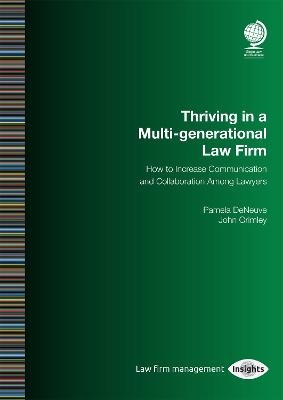
Thriving in a Multi-generational Law Firm
Globe Law and Business Ltd (Verlag)
978-1-78742-510-1 (ISBN)
- Titel z.Zt. nicht lieferbar
- Versandkostenfrei innerhalb Deutschlands
- Auch auf Rechnung
- Verfügbarkeit in der Filiale vor Ort prüfen
- Artikel merken
Thriving in a Multi-Generational Law Firm: How to Increase Communication and Collaboration Among Lawyers focuses on the question of whether four generations can co-exist and thrive in a law firm. Due to differences in communication styles, backgrounds, values, use of technology and work ethics, law firms and lawyers are encountering challenges to stability, profitability, and work satisfaction.
This Special Report identifies the conflicts between the different generations currently working in law firms, which, if they continue on their current trajectory, will compromise the long-held traditions and culture within the legal profession. It will address how generational differences set up conflicts between colleagues and will promote different ways to create positive change and harmony within firms. It contains a key analysis of why associates leave, the cost of turnover (which is in the billions of dollars), and what law firms can do to increase retention and productivity.
This title will provide readers with a more thorough understanding of the points of view of each generation operating in law firms. By utilising case studies from law firms of different sizes and from different locations, the book posits solutions to solving generational challenges law firms currently face. It is a practical, user-friendly guide to positive law firm change which will be valuable to partners, associates and professional development staff of all generations working in law firms of any size.
I. Introduction 9
1. Challenges in communication 9
1.1 Different ways of communicating 9
1.2 Use of technology 10
1.3 Work ethic 10
1.4 Turnover 10
1.5 Rising costs of attrition 10
1.6 Frustration between generations 10
1.7 Disharmony and low morale in the firm 11
1.8 Difficulty retaining women and minority lawyers 12
1.9 Threats to profitability 12
2. Navigating the challenges 12
II. Generations within law firms 15
1. The problem with blaming others 15
2. Understanding the generations 17
2.1 The silent generation (born 1925–1945) 17
2.2 The baby boomers (born 1946–1964) 18
2.3 Generation X (born 1965–1980) 20
2.4 Millennials (born 1981–1996) 21
2.5 Generation Z (born 1997–2015) 23
3. Summary 24
III. Inter-generational communication 25
1. Introduction 25
2. The solution begins with understanding 25
3. Better communication according to generation 26
3.1 The silent generation 26
3.2 Baby boomers 27
3.3 Gen X 27
3.4 Millennials 29
3.5 Gen Z 29
4. Summary 30
IV. Survey of lawyers 31
1. Introduction 31
2. Five questions about generational differences 32
2.1 Q 1 summary 36
2.2 Q 2 summary 39
2.3 Q 3 summary 42
2.4 Q 4 summary 44
2.5 Q 5 summary 46
3. Summary 46
V. A managing partner’s perspective 47
1. Introduction 47
2. Case studies: Oliver and Lionel 47
2.1 For every 20 associates hired, 15 leave 48
2.2 Why do young lawyers leave? 48
2.3 The costs of hiring 49
2.4 The solution 50
3. Summary 52
VI. Being lawyerly can be a problem 53
1. What being lawyerly means 53
2. Results of being lawyerly 54
3. IQ versus EQ 55
4. Why emotional intelligence is important 55
5. Characteristics of emotional intelligence 56
6. Lawyerly behaviours 59
7. Summary 59
VII. Building emotional intelligence – a step towards unity 61
1. Change is slow 61
2. Passing EQ to professional development won’t work 62
3. The beginning of EQ in your firm 63
VIII. Friction in the context of diversity, equity and inclusion 65
1. Gender 65
2. Bridging the gap with diversity and inclusion 66
2.1 Legacy structures 68
IX. The history of diversity in elite firms 69
1. Formation of white-shoe firms 69
2. Questions law firms should ask 70
3. Women lawyers and bias 71
4. Representation by race, ethnicity and gender 72
5. Double-barrelled biases 72
6. Solutions 72
7. The Mansfield Rule 73
8. Summary 73
X. The consequences of persisting generational friction 75
1. Introduction 75
2. Hiring and training costs 75
3. Changing workforce dynamics 77
4. Low workforce morale 77
5. Communication gaps 79
6. Different conversation styles 79
7. Communication in the context of COVID-19 80
8. Summary 80
XI. Throwing money at the problem will not solve the conflicts 81
1. Introduction 81
2. The complaints 81
3. Failed/counterproductive approaches 82
4. Approaches for lawyer retention and conflict resolution 82
4.1 Acknowledge change 82
4.2 Engage associates through teamwork 82
4.3 Encourage reverse mentoring 83
5. Summary 83
XII. Lawyer well-being – good and bad news 85
1. Introduction 85
2. Mental, emotional and physical health 85
3. Common ground 86
4. Law school 86
5. Well-being and lawyers 86
6. ABA report on well-being 88
7. Removing the stigma 88
8. Well-being and inter-generational communication 88
9. Unity from solutions 89
10. Awareness 89
11. Education 90
12. Engagement 92
13. Summary 92
XIII. Generations face off over post-COVID remote work 93
1. Introduction 93
2. A change of heart 93
3. The great resignation 94
4. Look to the future 96
XIV. The big picture 97
1. Questions for the leadership 97
2. Where to begin? 98
2.1 Assessment 98
2.2 Teamwork 98
3. Summary 100
XV. Thriving in a multi-generational law firm 101
1. Twenty-one steps 101
2. Summary 103
XVI. Conclusion 105
Notes 106
About the authors 109
About Globe Law and Business 111
| Erscheinungsdatum | 28.07.2021 |
|---|---|
| Verlagsort | London |
| Sprache | englisch |
| Maße | 210 x 297 mm |
| Themenwelt | Recht / Steuern ► EU / Internationales Recht |
| Recht / Steuern ► Privatrecht / Bürgerliches Recht ► Berufs-/Gebührenrecht | |
| ISBN-10 | 1-78742-510-X / 178742510X |
| ISBN-13 | 978-1-78742-510-1 / 9781787425101 |
| Zustand | Neuware |
| Haben Sie eine Frage zum Produkt? |
aus dem Bereich


